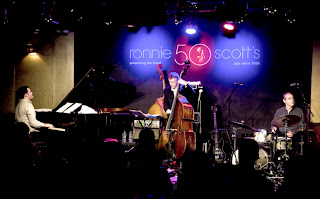10 Mar 2011
DJ8WX on 8.970022kHz again
Just weak a very weak trace overnight (you have to look hard!) from DJ8WX on VLF. Compared with his signals a few days ago he is at least 10dB weaker. Not sure why as nothing has been changed here. G3ZJO also copied Uwe weaker than before, although Eddie was getting him slightly better than me using his E-field probe antenna. By the way, this small trace (in blue/white) covers a period of 8 hours and is looking for the signal in an incredibly narrow 424uHz (yes you read it correctly - microhertz) bandwidth.
9 Mar 2011
10m WSPR DX today
 |
| 28MHz WSPR reports today |
Whilst doing other work I left the 10m WSPR beacon system running today. Some decent DX about with the best being reports from FR1GZ and the two Israeli stations.
8 Mar 2011
Dazed goldfinch
 |
| One dazed little goldfinch with a headache! |
This little goldfinch crashed into our bedroom window yesterday morning. When I looked, he was just sitting on the roof very dazed. I opened the window, took this photo from about 10cm, stroked him ....and off he flew!
Labels:
goldfinch
Jazz at Ronnie Scotts in London
 |
| Tim Lapthorn at Ronnie Scotts |
Our son Tim shown here on the piano at one of his many recent appearances at the world famous Ronnie Scotts jazz club in central London. His new album "Intentions" is due out later this year and will feature many of his new original compositions. See www.timlapthorn.com .
Labels:
jazz,
tim lapthorn
Latest NASA sunspot predictions
From the http://solarscience.msfc.nasa.gov/SunspotCycle.shtml website dated March 1st 2011:
"Current prediction for the next sunspot cycle maximum gives a smoothed sunspot number maximum of about 58 in July of 2013. We are currently over two years into Cycle 24. The predicted size would make this the smallest sunspot cycle in nearly 200 years."
Gloomy reading? Very recent solar levels in the last week or so may be just a blip, but something tells me we could all be in for a very big, and pleasant, surprise should activity continue to build as rapidly as it has recently. The sun is still full of surprises and no-one predicted the 2 year quiet sun we just had at the end of cycle 23.
I still find http://www.solen.info/solar/ the best page for up to date information on current solar activity.
Labels:
sunspots
6 Mar 2011
Doppler shift on 10m WSPR Transequatorial
This afternoon, before working some QRP DX on 10m and 12m SSB I had my WSPR system running and spotted FR1GZ (Reunion Is) several times at good levels. What was interesting was the Doppler shift on his signal which was up to -3Hz at times. I guess the propagation is trans-equatorial spread-F and what I'm observing are moving F-layers on the path between us.
Welcome back 10m "big time"
Today 10m sounded like the good old days with good strong contest signals from the USA and Canada as well as South America and Africa earlier in the day. I managed to work several stations in Texas, Alabama, Tennessee and Louisiana when running QRP SSB to the Homebase10 wire halo. This is the first time in around 5 years that I've heard the band like this. Welcome back good old 10m!
Labels:
10m,
6m qrp,
homebase10
A busy VLF amateur band (8-9kHz)
 |
| DK7FC's 8.97kHz grabber showing 4 stations active! |
This is REAL ham radio at the frontiers folks - put your cheque books away, forget those black boxes and join the fun on the Dreamer's Band.
Labels:
dreamers band,
vlf
5 Mar 2011
28MHz simple WSPR transceiver idea
Whilst playing with VXOs for my 10m DSB transceiver I realised that a cheap 14.060MHz crystal (available widely for about £1-2 each) would make a nice LO source for a 28MHz direct conversion WSPR transceiver. Doubled, the output is easily pulled to 28.1246MHz, the WSPR frequency. The PA does not have to be linear, so all that is needed apart from an oscillator/doubler is a single balanced mixer followed by a small PA. With the DSB approach, half the power is wasted and there would be an audio image 3kHz away on RX. However, the audio stages could be filtered to allow just 1.4-1.6kHz through. The whole transceiver could be extremely simple and stand-alone. I must build one.
ARRL SSB DX contest
Although there are US stations coming through on 15m, I've not yet heard any on 10m. Signals from LU1UM on 10m but nothing yet from North America. Sunspot count is high but conditions on 10m do not sound that good. Just worked N2PP on 15m SSB when using 10W to my 28MHz halo!
Labels:
arrl
Subscribe to:
Posts (Atom)


